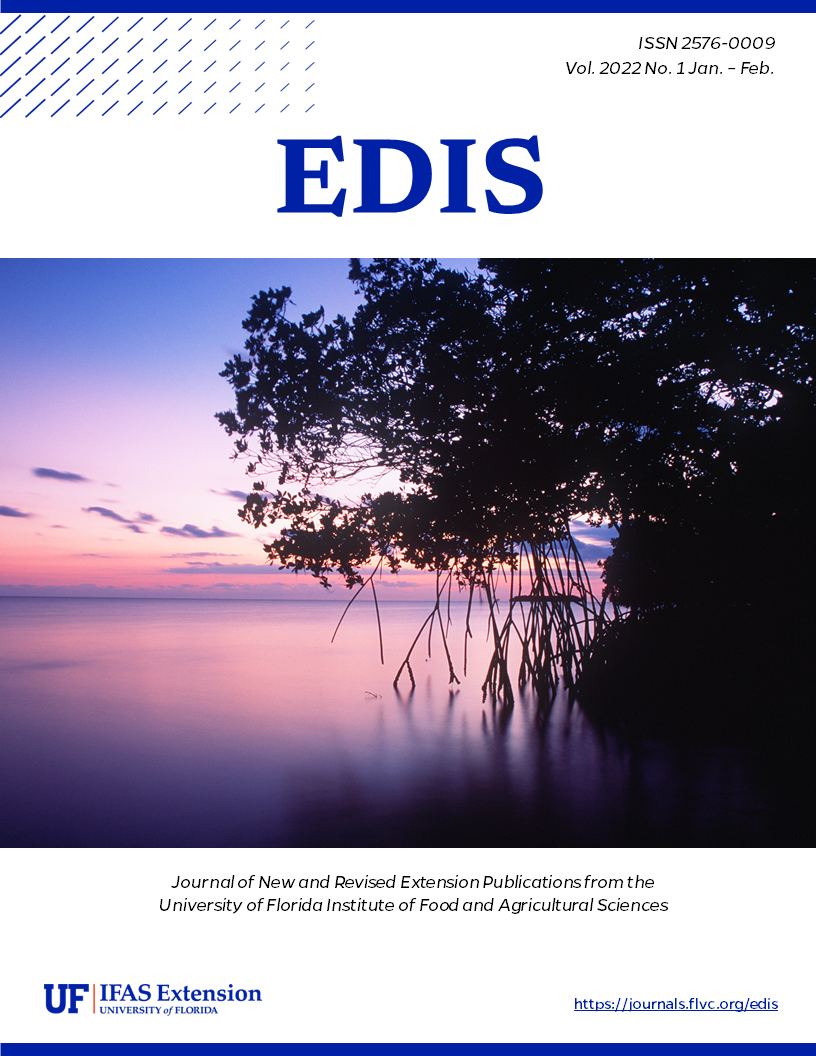Abstract
The Featured Creatures collection provides in-depth profiles of insects, nematodes, arachnids and other organisms relevant to Florida. These profiles are intended for the use of interested laypersons with some knowledge of biology as well as academic audiences.
Culex cedecei is a mosquito endemic to Florida, and a member of the Spissipes section of the subgenus Melanoconion of Culex. Several members of the Spissipes section are important vectors of enzootic subtypes of Venezuelan equine encephalitis virus (VEEV). Everglades virus (EVEV) is subtype II of VEEV in Florida, for which Culex cedecei is the primary enzootic vector. Culex cedecei is typically found in forested wetlands of southern Florida, ranging from mangrove swamps to hardwood hammocks and lowland pine ecosystems (Hoyer et al., 2019). Larvae of Culex cedecei develop in limestone solution holes, and abandoned crab burrows in a variety of habitats. Although Culex cedecei is not generally considered a pest of humans, it feeds primarily on muroid rodents (rats and mice), which are important hosts of EVEV in Florida. Culex cedecei is therefore considered a vector of a zoonotic pathogen that can affect human health.
References
Aguilar PV, Estrada-Franco JG, Navarro-Lopez R, Ferro C, Haddow AD, Weaver SC. 2011. Endemic Venezuelan equine encephalitis in the Americas: Hidden under the dengue umbrella. Future Virology 6(6): 721-740. https://doi.org/10.2217/fvl.11.50
Bigler WJ. 1969. Venezuelan encephalitis antibody studies in certain Florida wildlife. Journal of Wildlife Disease 5:267-270. https://doi.org/10.7589/0090-3558-5.3.267
Bigler WJ. 1971. Serologic evidence of Venezuelan equine encephalitis virus infections in raccoons of south central Florida. Journal of Wildlife Disease 7:166-170. https://doi.org/10.7589/0090-3558-7.3.166
Blosser EM. and N.D. Burkett-Cadena. 2017. Culex (Melanoconion) panocossa from peninsular Florida, USA. Acta tropica 167:59-63. https://doi.org/10.1016/j.actatropica.2016.12.024
Chamberlain RW, Sudia WD, Work TH, Coleman PH, Newhouse VF, Johnson JG. 1969. Arbovirus studies in south Florida, with emphasis on Venezuelan equine encephalomyelitis virus. American Journal of Epidemiology 89(3):197-210. https://doi.org/10.1093/oxfordjournals.aje.a120929
Darsie RF, Morris CD. 2003. Keys to the adult females and fourth instar larvae of the mosquitoes of Florida (Diptera: Culicidae). Technical Bulletin of the Florida Mosquito Control Association 1:1-159.
Darsie RF. 2005. Key to the pupae of the mosquitoes (Diptera: Culicidae) of Florida. Proceedings of the Entomological Society of Washington 107(4): 892-902.
Darsie RF, Ward RA. 2005. Identification and geographical distribution of the mosquitoes, North of Mexico. University of Florida Press Gainesville, FL.
Dziem GM, Cupp EW. 1983. Laboratory bionomics of Culex (Melanoconion) taeniopus. Mosquito News 43(2): 170-175.
Edman JD. 1974. Host-feeding patterns of Florida mosquitoes III. Culex (Culex) and Culex (Neoculex). Mosquito News 11(1):95-104. https://doi.org/10.1093/jmedent/11.1.95
Edman JD. 1979. Host-feeding patterns of Florida mosquitoes (Diptera: Culicidae) VI. Culex (Melanoconion). Journal of Medical Entomology 15(5-6):521-525. https://doi.org/10.1093/jmedent/15.5-6.521
Ehrenkranz NJ, Ventura AK. 1974. Venezuelan equine encephalitis virus infection in man. Annual Review of Entomology 25:9-14. https://doi.org/10.1146/annurev.me.25.020174.000301
Ehrenkranz NJ. 1970. The natural occurrence of Venezuelan equine encephalitis in the United States. The New England Journal of Medicine 282:298-302. https://doi.org/10.1056/NEJM197002052820603
Foote RH. 1954. The larvae and pupae of the mosquitoes belonging to the Culex subgenera Melanoconion and Mochlostyrax. Technical Bulletin No. 1091, United States Department of Agriculture.
Hoyer IJ, Blosser EM, Acevedo C, Thompson AC, Reeves LE, Burkett-Cadena ND. 2017. Mammal decline, linked to invasive Burmese python, shifts host use of vector mosquitoes towards reservoir hosts of a zoonotic disease. Biology Letters 13: 20170353. https://doi.org/10.1098/rsbl.2017.0353
Hoyer IJ, Acevedo C, Wiggins K, Alto B, Burkett-Cadena ND. 2019. Patterns of abundance, host-use, and Everglades virus infection in Culex (Melanoconion) cedecei mosquitoes, Florida, USA. Emerging Infectious Disease 25(6):1093-1100. https://doi.org/10.3201/eid2506.180338
Pratt HD, Wirth WW, Denning DG. 1945. The occurrence of Culex opisthopus Komp in Puerto Rico and Florida, with a description of the larva (Diptera, Culicidae). Proceedings of the Entomological Society of Washington 28(1): 39-41.
Sallum MA, Forattini OP, 1996. Revision of the Spissipes section of Culex (Melanoconion) (Diptera: Culicidae). Journal of the American Mosquito Control Association 12(3):517-600.
Sirivanakarn S, Belkin JN. 1980. The identity of Culex (Melanoconion) taeniopus Dyar and Knab and related species with notes on the synonymy and description of a new species (Diptera: Culicidae). Mosquito Systematics 12(1): 7-24.
Stone A, Hair JA. 1968. A new Culex (Melanoconion) from Florida (Diptera: Culicidae). Mosquito News 28(1):39-41.
Ventura EK, Buff EE, Ehrenkranz NJ. 1974. Human Venezuelan equine encephalitis virus infection in Florida. American Journal of Tropical Medicine and Hygiene 23: 507-512. https://doi.org/10.4269/ajtmh.1974.23.507
Weaver SC, Sherer WF, Taylor CA, Castello DA, Cupp EW. 1986. Laboratory vector competence of Culex (Melanoconion) cedecei for sympatric and allopatric Venezuelan equine encephalomyelitis viruses. American Journal of Tropical Medicine and Hygiene 35: 619-623. https://doi.org/10.4269/ajtmh.1986.35.619
West RG, Mathias DR, Day JF, Boohene CK, Unnasch TR, Burkett-Cadena ND. 2020. Vectorial capacity of Culiseta melanura (Diptera: Culicidae) changes seasonally and is related to epizootic transmission of Eastern Equine Encephalitis Virus in Central Florida. Frontiers in Ecology and Evolution, 8:270. https://doi.org/10.3389/fevo.2020.00270

